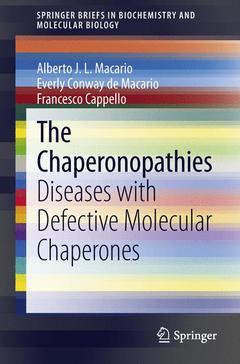The Chaperonopathies, 2013 Diseases with Defective Molecular Chaperones SpringerBriefs in Biochemistry and Molecular Biology Series

This Brief provides a concise review of chaperonopathies, i.e., diseases in which molecular chaperones play an etiologic-pathogenic role. Introductory chapters deal with the chaperoning system and chaperoning teams and networks, HSP-chaperone subpopulations, the locations and functions of chaperones, and chaperone genes in humans. Other chapters present the chaperonopathies in general, including their molecular features and mechanistic classification into by defect, excess, or mistake. Subsequent chapters discuss the chaperonopathies in more detail, focusing on their distinctive characteristics: primary or secondary; quantitative and/or qualitative; structural and hereditary or acquired; genetic polymorphisms; gene dysregulation; age-related; associated with cancer, chronic inflammatory conditions, and autoimmune diseases. The interconnections between the chaperoning and the immune systems in cancer development, chronic inflammation, autoimmunity, and ageing are outlined, which leads to a discussion on the future prospects of chaperonotherapy. The latter may consist of chaperone gene and protein replacement/supplementation in cases of deficiency and of gene or protein blocking when the chaperone actively promotes disease. The last chapter presents the extracellular chaperones and details on how the chaperone Hsp60 is secreted into the extracellular space and, thus, appears in the blood of cancer patients with potential to participate in carcinogenesis and chronic inflammation and autoimmunity. Chaperones as clinically useful biomarkers are mentioned when pertinent. Likewise, guidelines for clinical evaluation of chaperonopathies and for their histopathological and molecular identification are provided throughout. The book also provides extensive bibliography organized by chapter and topic with comments.
A unique and comprehensive survey and description of diseases, the chaperonopathies, in which molecular chaperones are etiologic-pathogenic factors
An easy-to-grasp, well-illustrated with tables and figures, panoramic view of the state-of-the-art analysis of chaperonopathies
Unveils new routes to diagnose chaperonopathies, establish prognosis, treat and manage patients properly, thereby showing the path for future research
Date de parution : 04-2013
Ouvrage de 116 p.
15.5x23.5 cm



